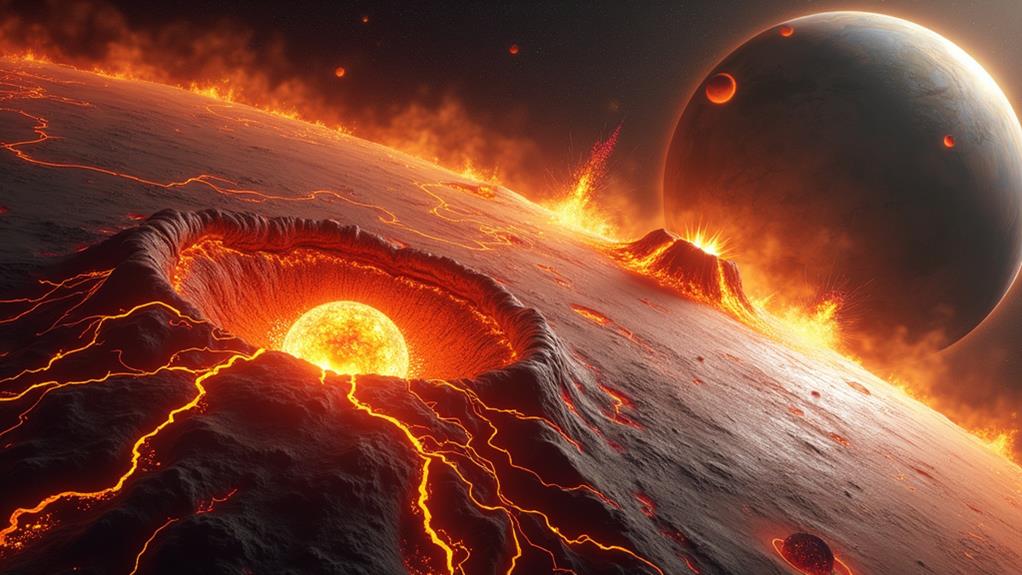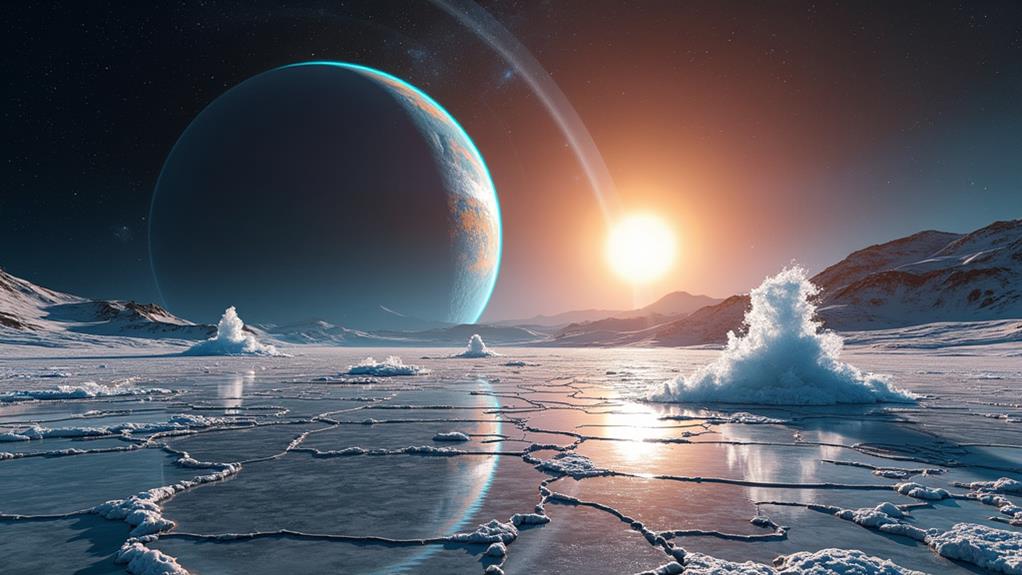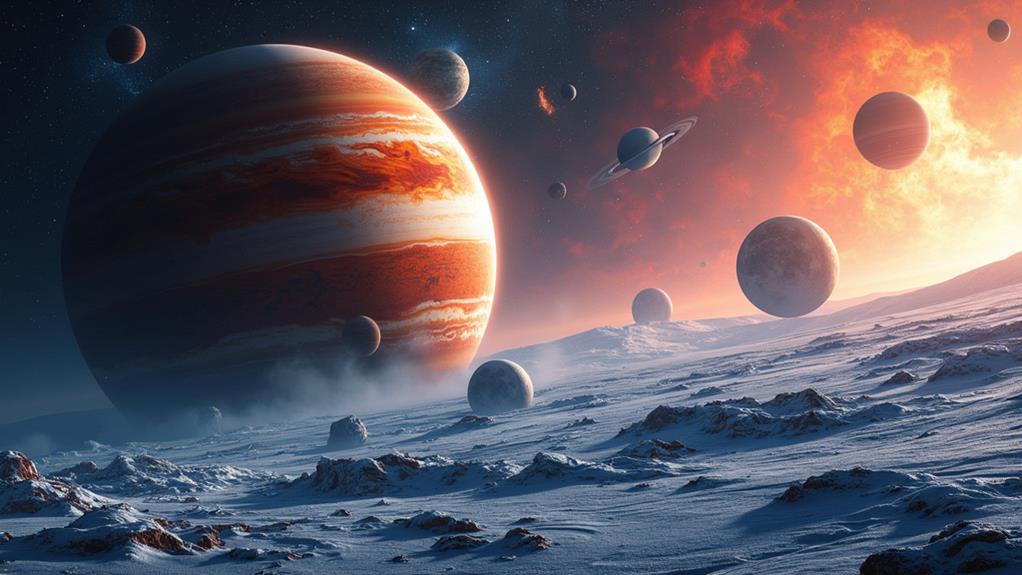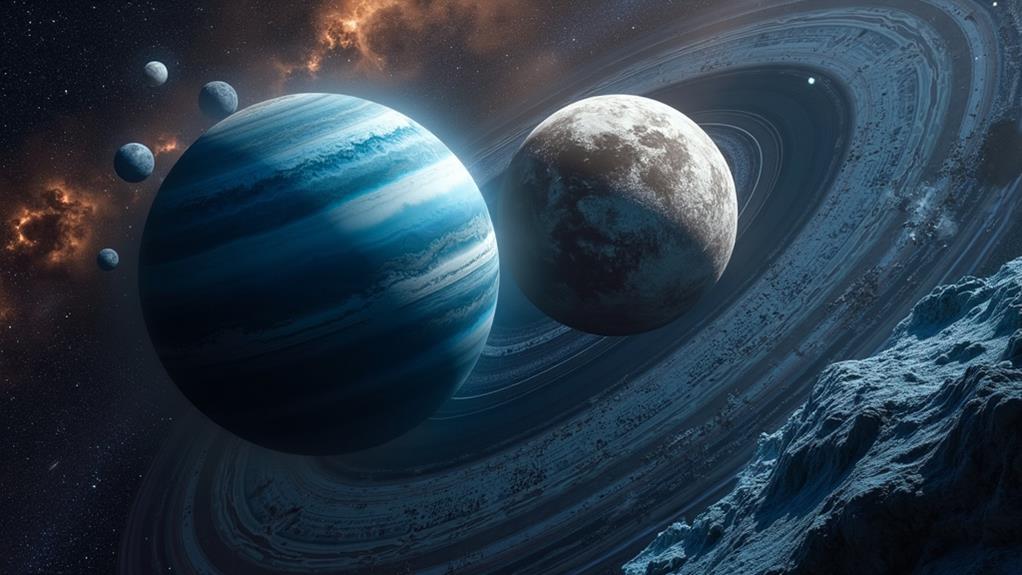Why Does Earth's Moon Have Unique Geological Features?
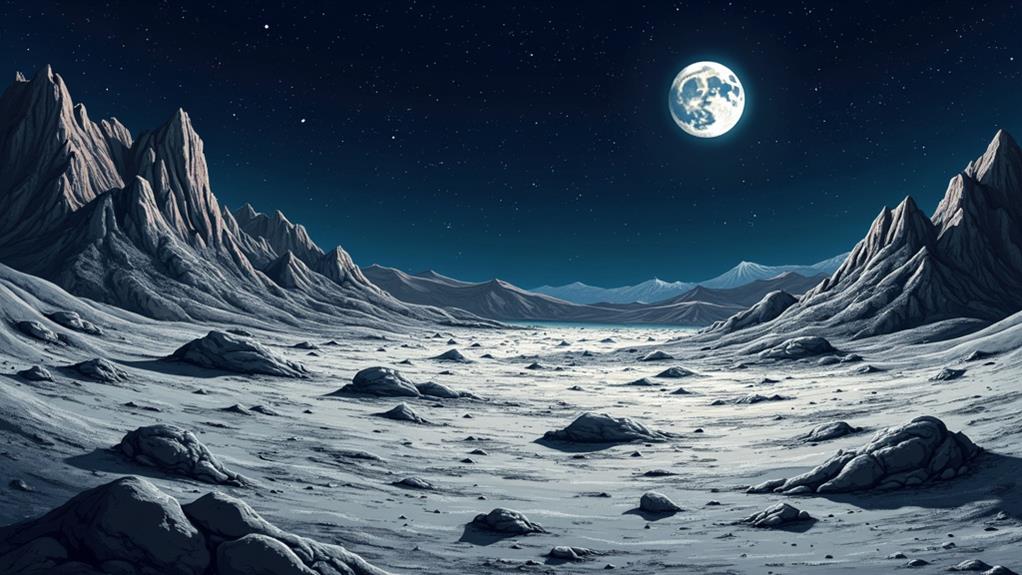
You find Earth's Moon fascinating because its unique geological features provide a window into early solar system history. Unlike Earth, the Moon doesn't have plate tectonics, so its surface doesn't recycle, preserving ancient crust for billions of years. Impact craters, volcanic activity, and vast basalt plains called maria tell a story of constant bombardment and eruptions. The lack of atmosphere means it's a pristine record of these events, and features like lunar swirls and permanently shadowed regions add to its mystery. By exploring these aspects, you'll gain a deeper understanding of our celestial neighbor's geological wonders.
Key Takeaways
- The Moon's lack of plate tectonics preserves its ancient surface, providing insights into early solar system history.
- Extensive impact cratering, with over 300,000 craters, defines the Moon's geological landscape.
- Volcanic activity, primarily effusive, formed the lunar maria and influenced the surface over billions of years.
- The presence of lunar swirls and permanently shadowed regions offers clues to unique space weathering and volatile preservation.
- The anorthositic highlands and mare basalt plains reveal the Moon's diverse crustal composition and geological evolution.
Lack of Plate Tectonics
Unlike Earth, the Moon is a one-plate planet, meaning it doesn't have the tectonic plates that you might be familiar with. This lack of plate tectonics has greatly shaped the Moon's geological history. Without the dynamic movement of plates recycling crustal material, the lunar surface has remained relatively unchanged for over 3 billion years.
On Earth, tectonic activity constantly reshapes the landscape, but the Moon's surface tells a different story. Over 99% of the Moon's surface is ancient, dominated by impact craters formed from collisions with meteoroids and asteroids. These craters, along with basins and maria, are evidence of the Moon's exposure to external impacts rather than internal geological processes.
Interestingly, the Moon does exhibit some geological features like wrinkle ridges and rilles. These are formed primarily through thermal contraction and volcanic activity rather than from tectonic movements. Volcanic activity on the Moon has also contributed to its unique landscape, creating plains of solidified lava known as maria.
In essence, the Moon's lack of plate tectonics has preserved its ancient surface, providing a window into its geological history dominated by impacts and minimal volcanic reshaping. This makes the Moon a fascinating celestial body to study for clues about the early solar system.
Impact Cratering
Impact cratering stands as one of the most defining aspects of the Moon's geological landscape. When you look at the Moon through a telescope, you can't miss the immense number of impact craters dotting its surface. Unlike Earth, the Moon doesn't have an atmosphere to protect it from meteoroids and asteroids, resulting in a preserved record of its geological history. Over billions of years, more than 300,000 craters larger than 1 kilometer in diameter have formed, some over 4 billion years old.
Lunar craters aren't just holes in the ground; they have distinct features like rays of ejected material, which can stretch hundreds of kilometers from the impact site. These rays offer clues about the energy and dynamics involved in the impacts. The largest impact basins, such as the Imbrium and Serenitatis basins, display extensive geological changes. Surrounding these basins, you'll find rings of mountains formed from the rebound of the lunar crust after impact.
Crater counting is an essential method for piecing together the Moon's geological history. By examining the density of craters in different regions, scientists can estimate the relative timeframes of lunar geological units.
Volcanic Activity
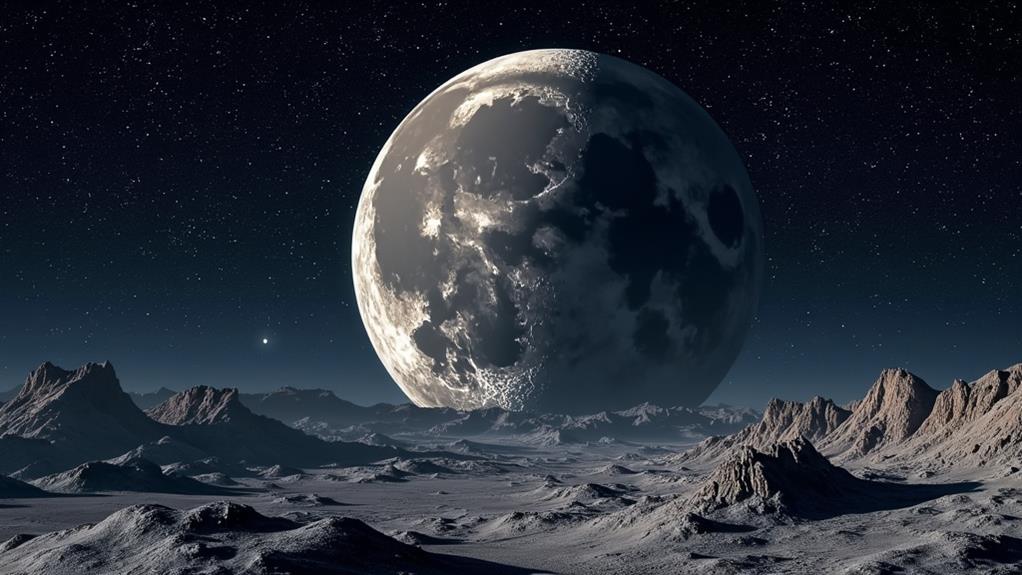
Volcanism played a crucial role in shaping the Moon's surface, offering a glimpse into its fiery past. Between 3 billion and 1 billion years ago, volcanic activity on the Moon was at its peak, with basaltic lava flowing into large basins and impact craters. These ancient volcanic activities led to the creation of the lunar maria, the vast dark plains that you see when you look at the Moon. These maria are primarily formed from basaltic lava, similar in chemical composition to volcanic rocks on Earth, rich in iron and magnesium.
Interestingly, recent studies suggest that some eruptions may have occurred as recently as 100 million years ago, indicating that the Moon's volcanic activity didn't completely cease billions of years ago. The volcanic activity on the Moon was mostly effusive, meaning that it created smooth, flat surfaces rather than towering volcanic structures. This is why the lunar maria appear so flat and expansive.
Adding to this, the presence of irregular mare patches (IMPs) suggests that some lunar volcanic activity involved silicic lava, which has a higher silica content compared to typical basaltic lava flows. These IMPs give us further insights into the Moon's complex volcanic history and chemical composition.
Lunar Regolith
Beneath the Moon's surface lies the fascinating and complex layer known as lunar regolith. This loose, fragmented material, formed over 4.6 billion years, owes its existence primarily to meteoroid impacts and solar radiation. Unlike terrestrial soil, lunar regolith lacks organic content, creating ongoing debates about its classification. The Apollo missions provided invaluable samples, revealing the regolith's composition of mineral grains and its varying thickness—4-5 meters in mare regions and 10-15 meters in the highlands.
When exploring the lunar surface, understanding the mechanical properties of lunar regolith is vital. These properties affect the safety and feasibility of construction, in addition to the landing and mobility of lunar rovers and habitats. The density of the regolith increases with depth, which influences how you might build and move equipment.
Moreover, lunar regolith isn't just a geological curiosity; it holds valuable resources. In permanently shadowed regions, potential water ice could be a game-changer for future lunar missions and sustained exploration. By tapping into these resources, you could support longer stays on the Moon, making lunar regolith a significant focus for anyone interested in the Moon's unique geological features.
Anorthositic Highlands
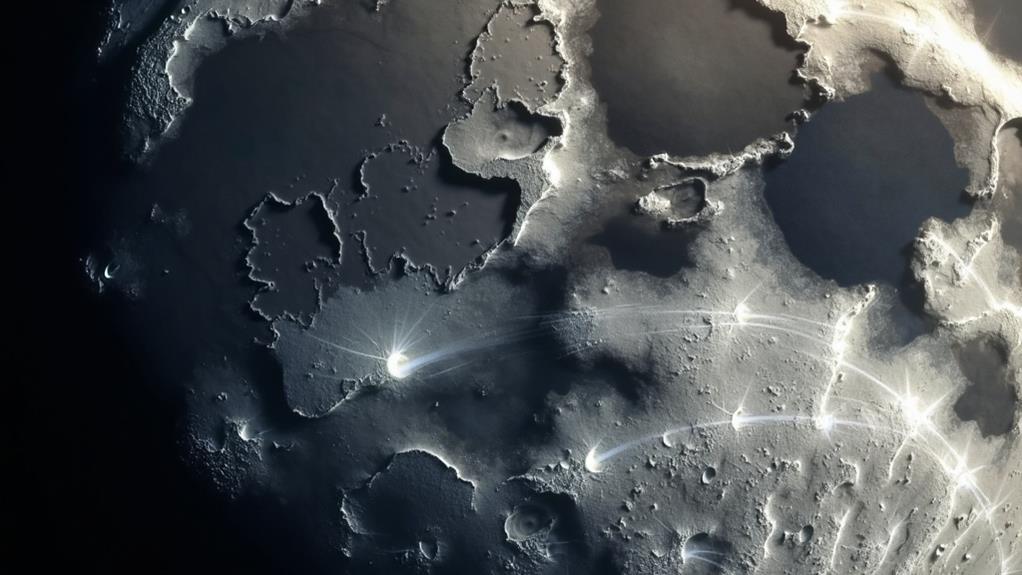
Throughout the Moon's history, the anorthositic highlands have captivated scientists with their rich geological story. These highlands are primarily composed of calcium-rich plagioclase feldspar, which represents the original crust formed during the Moon's early history. This material is less dense than the basaltic rocks that later filled lunar impact basins, allowing it to float and dominate the lunar surface.
When you look at the Moon, the brighter areas you see are these anorthositic highlands. They exhibit rugged terrain, marked by numerous ancient impact craters. These craters tell a tale of a tumultuous past, with some regions of anorthosite estimated to have formed over 4 billion years ago. Despite the Moon's dynamic history of impacts and volcanic activity, many of these ancient geological features have remained preserved.
The dominance of anorthositic material in the highlands is quite evident. Approximately 83% of the lunar surface is comprised of these ancient highlands, showcasing their extensive distribution. When you examine Moon rock samples, the presence of calcium-rich plagioclase feldspar highlights the significance of these highlands in understanding the Moon's geological evolution.
Mare Basalt Plains
The mare basalt plains, also known as lunar maria, are some of the most striking features on the Moon's surface. These vast, dark, and flat areas were formed by ancient volcanic activity and are primarily composed of iron- and magnesium-rich basalt rock, similar to Earth's volcanic rocks. You can see these basaltic plains filling impact basins and craters, creating smoother surfaces compared to the rugged highlands.
The side of the Moon facing Earth hosts the most extensive mare regions, including the largest one, Mare Imbrium. This massive mare, about 1,145 kilometers in diameter, originated from a significant impact around 3.8 billion years ago, followed by extensive volcanic flooding. The samples collected during the Apollo missions revealed that mare basalts are younger than the highlands, with some dating back to about 3 billion years ago.
These mare regions exhibit unique geological features like wrinkle ridges, formed by the contraction of the basalt as it cooled. By studying these ridges and other characteristics, you gain valuable insights into the Moon's volcanic history and tectonic processes, enhancing your understanding of its fascinating geological evolution.
Lunar Swirls
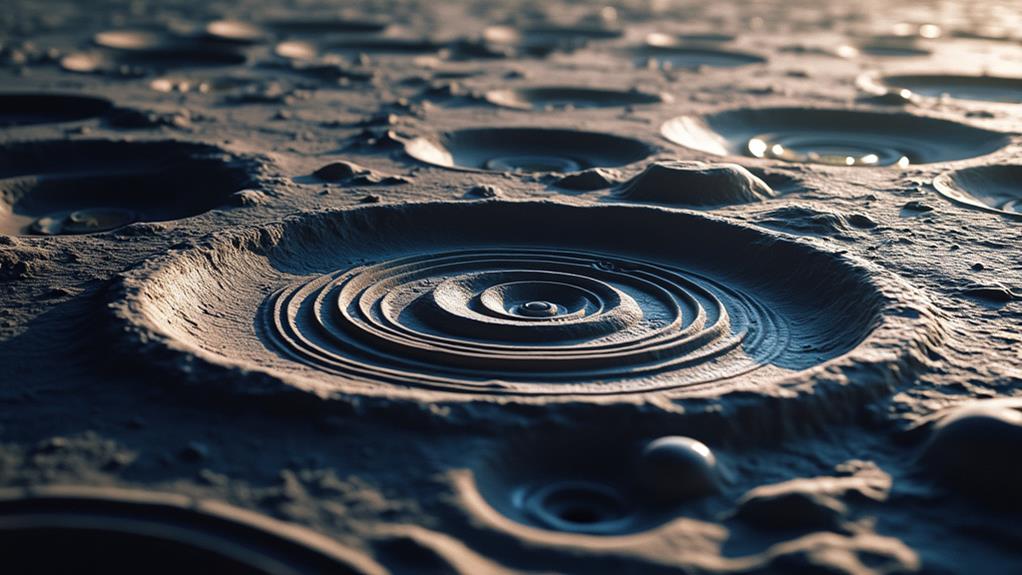
Lunar swirls are some of the Moon's most fascinating and mysterious features, characterized by their bright, curly patterns that stand out against the darker lunar surface. Unlike other geological features, these swirls aren't linked to topographic changes but are thought to be influenced by local magnetic fields. Prominent examples like Reiner Gamma are particularly enchanting.
The origin of lunar swirls is still debated. One theory suggests they result from the interaction of solar wind with magnetized underground volcanic dikes. These magnetic fields could create mini magnetic shields that protect the underlying regolith from the weathering effects of solar radiation. This shielding effect might explain why some areas remain brighter than the surrounding terrain.
Lunar swirls exhibit varying brightness and morphology, hinting at differences in the regolith's composition and the intensity of magnetic fields in those regions. By studying these unique formations, you gain valuable insights into the Moon's magnetic history and how solar and cosmic radiation impacts its surface.
These bright, curly patterns aren't just visually striking; they also hold clues to the lunar environment's past and the complex interplay between the Moon's surface, magnetic fields, and solar radiation.
Permanently Shadowed Regions
Situated near the Moon's poles, Permanently Shadowed Regions (PSRs) are areas that never receive direct sunlight, plunging them into extreme cold. These regions maintain temperatures around -230°C (-382°F), making them some of the coldest places in the solar system. The extreme cold in PSRs allows water ice to remain preserved for billions of years, offering a fascinating glimpse into the Moon's geological history.
For lunar exploration, PSRs hold significant potential. The Lunar Trailblazer mission aims to map the abundance of water ice in these regions, providing critical data for future explorations. Understanding the distribution of water ice will be crucial for sustaining future human missions to the Moon, as water is fundamental for life support and could be converted into fuel.
PSRs aren't just icy vaults; they also contain carbon dioxide and other volatiles. These materials could be priceless resources for long-term lunar habitation. The unique conditions in PSRs can reveal much about the Moon's past and the processes that have shaped its surface over billions of years. By exploring these shadowy depths, you'll uncover secrets that could pave the way for humanity's future on the Moon.
Recent Geological Activity
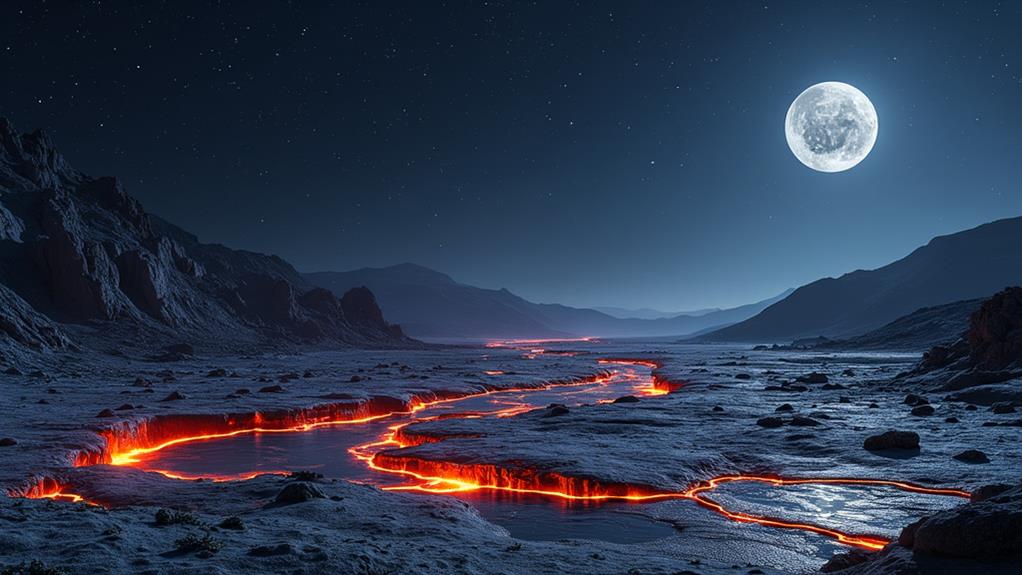
In recent years, scientists have revealed compelling evidence of ongoing geological activity on the Moon. By using data from the Lunar Reconnaissance Orbiter (LRO), they've identified over 200 new impact craters formed in just the past seven years. These impacts highlight the Moon's dynamic surface environment and ongoing geological processes.
Notably, evidence suggests young lunar volcanism might have occurred as recently as 100 million years ago. This revelation points to a more active geological history than we previously understood. Irregular Mare Patches (IMPs) on the lunar surface further support the notion of diverse and relatively recent volcanic activity. These surface features indicate that the Moon isn't as geologically dormant as once thought.
Another fascinating finding involves floor-fractured craters, which exhibit shallow, bowed floors with visible fractures. These peculiar formations are believed to result from magma intrusion beneath the surface, providing insights into the Moon's internal geological processes. The LRO's images have been essential in revealing these dynamic changes and helping us understand the Moon's evolving landscape.
As you can see, the Moon's geology is far from static, continuously shaped by impacts, volcanism, and other geological activities.
Unique Mineralogy
While the Moon's geological activity reveals a dynamic and evolving landscape, its unique mineralogy offers a window into its ancient past. One of the standout features of lunar soil is the high abundance of plagioclase feldspar, especially in the anorthositic highlands. This mineral formed billions of years ago from the crystallization of lunar magma, giving us clues about the Moon's early geochemical evolution.
In contrast, the mare regions are controlled by basaltic lava flows, mainly composed of iron and magnesium-rich minerals like pyroxene and olivine. These flows are remnants of ancient volcanic activity, shaping the Moon's surface as we see it today. The Apollo missions provided invaluable samples, revealing KREEP (potassium, rare earth elements, and phosphorus) in the Procellarum KREEP Terrane. This finding highlights a unique geochemical evolution not seen on Earth.
The Moon's lack of water and organic materials contributes to its distinct mineral composition. Lunar regolith is mainly made up of silicates and oxides, such as ilmenite and anorthite. In addition, the Moon's surface mineralogy has remained relatively unchanged for billions of years due to its lack of tectonic processes and a thin atmosphere, limiting weathering and erosion.
Frequently Asked Questions
What Makes Earth's Moon Unique?
Imagine standing on a surface unchanged for over 3 billion years. Earth's Moon is unique due to its lunar formation and tidal locking, which keep one side facing Earth. Its surface composition includes regolith characteristics like sharp, abrasive particles from micrometeorite impacts. Impact craters and volcanic history reveal a fascinating past. With no tectonic activity, the Moon's ancient volcanic plains and highlands remain a reflection of its geological story.
What Are the Geological Features of the Moon?
When you look at the Moon, you'll notice its geological features like lunar maria, which are dark volcanic plains. Impact craters dominate the surface, revealing its ancient past. The regolith composition varies, with a thicker layer over the highlands. Volcanic activity and tectonic history are evident from wrinkle ridges and rilles. Furthermore, polar ice exists in permanently shadowed regions, contributing to the Moon's intriguing geological diversity.
What Are the Unique Features of Moon?
When you investigate the Moon, you'll notice unique features like lunar maria, which are dark volcanic plains. Impact craters dominate its surface, revealing its history. The regolith composition includes fine dust and rocky debris. The highlands boast raised, ancient anorthositic crust. Volcanic activity has left behind wrinkle ridges and sinuous rilles, showcasing tectonic features despite the lack of plate tectonics. These elements make the Moon's landscape truly distinctive.
How Is the Geology of the Moon Different From Earth?
Imagine stepping into a time machine. The Moon's geology differs from Earth's because it has lunar maria and impact craters preserved for eons due to lack of surface erosion. Its regolith composition is distinct, lacking Earth's varied soil profiles influenced by life. Without tectonic history, the Moon's features stem from volcanic activity and impacts, unlike Earth's tectonic-driven changes. The Moon's surface remains largely unchanged, a stark contrast to Earth's dynamic crust.

